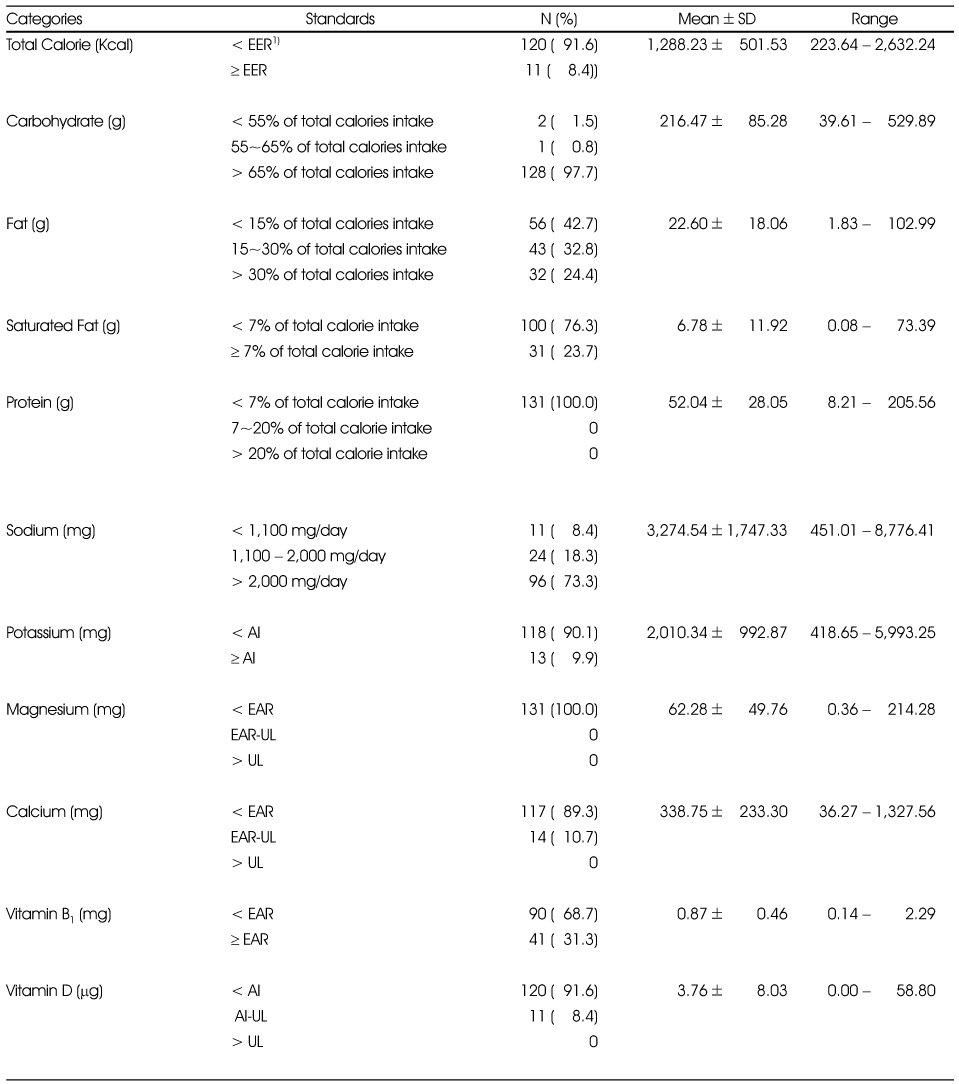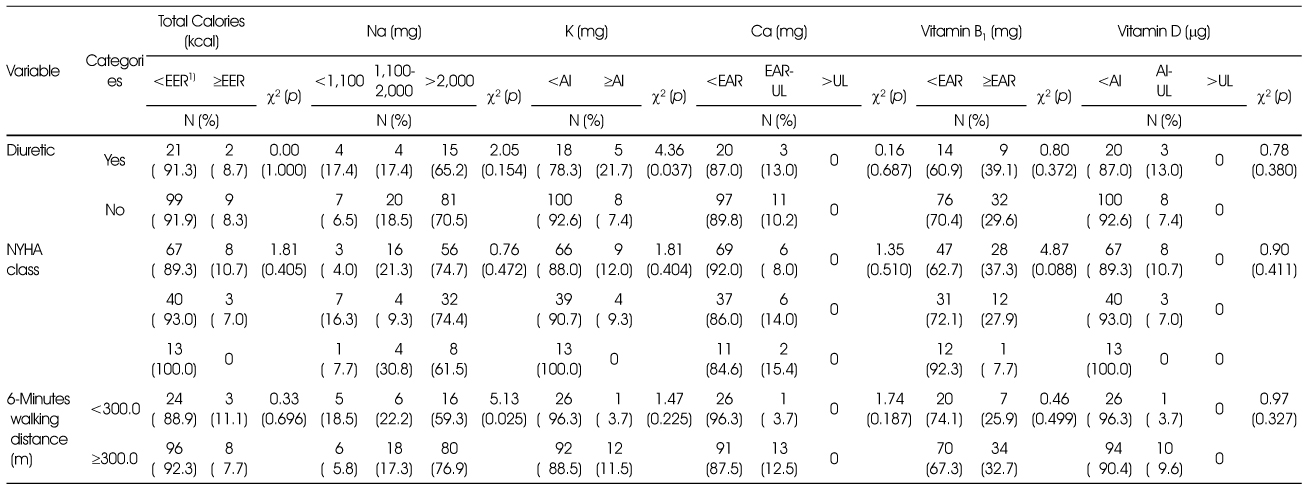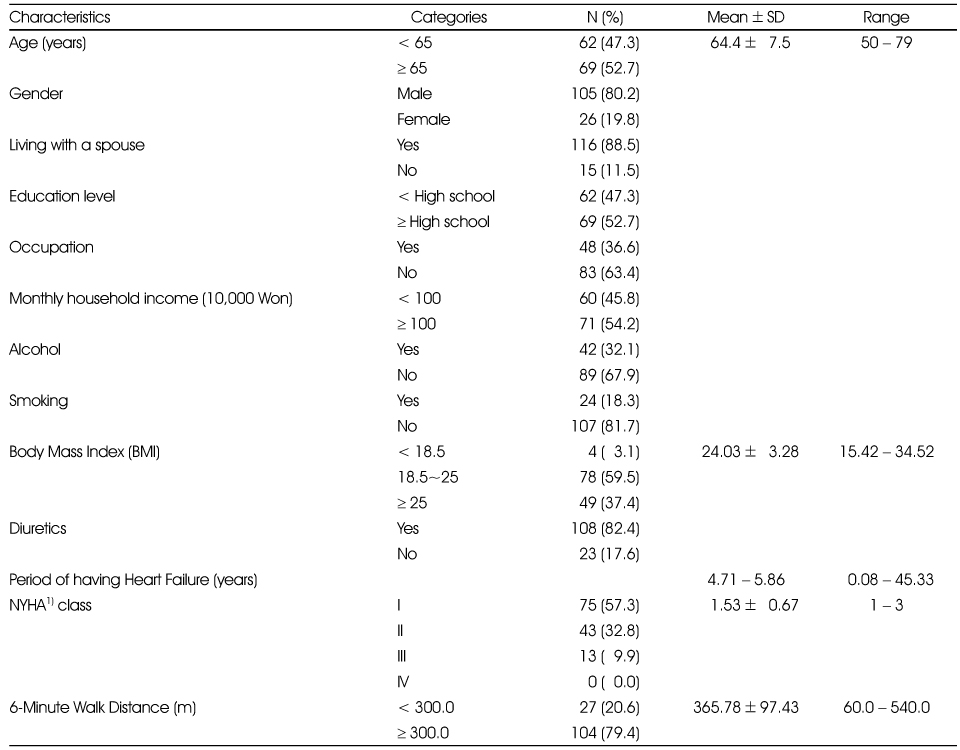Articles
- Page Path
- HOME > Korean J Community Nutr > Volume 21(2); 2016 > Article
-
Research Article
- The Nutrient Intakes and their Relationships with the Use of Diuretics, Symptom Severity and Physical Functioning in Heart Failure Patients
-
Jun Hee Jang, Haejung Lee
 , Youngjoo Park, Kook Jin Chun, Jong Hyun Kim
, Youngjoo Park, Kook Jin Chun, Jong Hyun Kim -
Korean Journal of Community Nutrition 2016;21(2):190-199.
DOI: https://doi.org/10.5720/kjcn.2016.21.2.190
Published online: April 30, 2016
1School of Nursing, Pusan National University, Yangsan, Korea.
2Department of Internal Medicine, Pusan National University Yangsan Hospital,/College of Medicine, Pusan National University, Yangsan, Korea.
3Department of Internal Medicine, BHS Hanseo Hospital, Busan, Korea.
- Corresponding author: Haejung Lee. College of Nursing, Pusan National University, 20, Geumoro, Mulgeum-eup, Yangsan 50612, Korea. Tel: (051) 510-8344, Fax: (051) 510-8308, haejung@pusan.ac.kr
Copyright © 2016 The Korean Society of Community Nutrition
This is an Open-Access article distributed under the terms of the Creative Commons Attribution Non-Commercial License (http://creativecommons.org/licenses/by-nc/3.0/) which permits unrestricted non-commercial use, distribution, and reproduction in any medium, provided the original work is properly cited.
- 1,041 Views
- 1 Download
- 1 Crossref
Abstract
-
Objectives
- The purpose of this study was to identify the differences in nutrient intake according to using diuretics, symptom severity and degree of physical functioning in heart failure patients.
-
Methods
- A secondary data analysis was conducted by using baseline data of an intervention study for heart failure patients. In this study, 131 heart failure patients were included. Data were collected using medical records, NYHA (New York Heart Association functional classification) class, and 6-minute-walking test and 24-hour diet recall. Data were analyzed using descriptive statistics and Chi-square test by SPSS 21.0. Nutrient intake was assessed using CAN-pro 2.0.
-
Results
- Majority of the participants consumed total calorie less than Estimated Energy Requirement (EER) and consumed carbohydrates more than 65% of their total calorie intakes. 24.4% of the participants consumed fat more than 30% of their total calorie intakes and 23.7% consumed saturated fat more than 7% of their total calorie intakes. 100.0% of the participants consumed protein less than 7% of their total calorie intakes and 73.3% of the participants consumed more than recommended intakes of sodium. More than 90.0% of the participants consumed less than adequate intakes of potassium (90.1%) and Vitamin D (91.6%), respectively. 100% and 62.6% of the participants consumed less than Estimated Average Requirement (EAR) of magnesium and Vitamin B1, respectively. Nutrient intakes in heart failure patients were different for potassium intake according to the usage of diuretics. The participants with symptom severity tended to intake protein less properly and the participants walking more than 300.0 m tended to intake sodium improperly high.
-
Conclusions
- The findings of this study indicated the need for screening nutrient intakes of heart failure patients. It is necessary to increase the intake of total calories and most nutrients and to restrict sodium intakes among heart failure patients.
Acknowledgments
Acknowledgments
- 1. Makarewicz-Wujec M, Kozłowska-Wojciechowska M, Sygnowska E, Waśkiewicz A. Does heart failure determine the nutrition of patients? Kardiol Polska 2013; 72(1): 56-63.ArticlePubMed
- 2. Lennie TA, Moser D, Biddle MJ, Welsh D, Bruckner GG, Thomas DT. Nutrition intervention to decrease symptoms in patients with advanced heart failure. Res Nurs Health 2013; 36(2): 120-145.ArticlePubMedPMCPDF
- 3. Obisesan TO, Toth MJ, Donaldson K, Gottlieb SS, Fisher ML, Vaitekevicius P. Energy expenditure and symptom severity in men with heart failure. Am J Cardiol 1996; 77(14): 1250-1252.ArticlePubMed
- 4. Pasini E, Opasich C, Pastoris O, Aquilani R. Inadequate nutritional intake for daily life activity of clinically stable patients with chronic heart failure. Am J Cardiol 2004; 93(8A): 41A-43A.ArticlePubMed
- 5. Lourenço BH, Vieira LP, Macedo A, Nakasato M, Marucci MDFN, Bocchi EA. Nutritional status and adequacy of energy and nutrient intakes among heart failure patients. Arq Bras Cardiol 2009; 93(5): 541-548.
- 6. Hughes CM, Woodside JV, McGartland C, Roberts MJ, Nicholls DP, McKeown PP. Nutritional intake and oxidative stress in chronic heart failure. Nutr Metab Cardiovasc Dis 2012; 22(4): 376-382.ArticlePubMed
- 7. Price RJ, Witham MD, McMurdo ME. Defining the nutritional status and dietary intake of older heart failure patients. Eur J Cardiovasc Nurs 2007; 6(3): 178-183.ArticlePubMedPDF
- 8. Aquilani R, Opasich C, Verri M, Boschi F, Febo O, Pasini E. Is nutritional intake adequate in chronic heart failure patients? J Am Coll Cardiol 2003; 42(7): 1218-1223.ArticlePubMed
- 9. Lee H, Kang B, Chung HK, Do HJ, Shim JS, Bae SH. The assessment for nutrient intakes of Korean patients with heart failure. Korean J Nutr 2010; 43(3): 224-232.Article
- 10. Bonilla-Palomas JL, Gámez-López AL, Anguita-Sánchez MP, Castillo-Domínguez JC, García-Fuertes D, Crespin-Crespin M, et al. Impact of malnutrition on long-term mortality in hospitalized patients with heart failure. Rev Esp Cardiol 2011; 64(9): 752-758.ArticlePubMed
- 11. Narumi T, Arimoto T, Funayama A, Kadowaki S, Otaki Y, Nishiyama S. The prognostic importance of objective nutritional indexes in patients with chronic heart failure. J Cardiol 2013; 62(5): 307-313.ArticlePubMed
- 12. Dunn SP, Bleske B, Dorsch M, Macaulay T, Van Tassell B, Vardeny O. Nutrition and heart failure: impact of drug therapies and management strategies. Nutr Clin Pract 2009; 24(1): 60-75.ArticlePubMedPDF
- 13. Cooper HA, Dries DL, Davis CE, Shen YL, Domanski MJ. Diuretics and risk of arrhythmic death in patients with left ventricular dysfunction. Circulation 1999; 100(12): 1311-1315.ArticlePubMed
- 14. Dudek SG. Nutrition essentials for nursing practice. 7th ed. Lippincott Williams & Wilkins; 2013.
- 15. Evangelista LS, Heber D, Li Z, Bowerman S, Hamilton MA, Fonarow GC. Reduced body weight and adiposity with a high-protein diet improves functional status, lipid profiles, glycemic control, and quality of life in patients with heart failure: a feasibility study. J Cardiovasc Nurs 2009; 24(3): 207.PubMedPMC
- 16. Shimon H, Almog S, Vered Z, Seligmann H, Shefi M, Peleg E. Improved left ventricular function after thiamine supplementation in patients with congestive heart failure receiving long-term furosemide therapy. Am J Med 1995; 98(5): 485-490.ArticlePubMed
- 17. American Heart Association. Classes of heart failure [internet]. American Heart Association; 2011; cited 2016 Jan 16]. Available from: http://www.heart.org/HEARTORG/Conditions/HeartFailure/AboutHeartFailure/Classes-of-Heart-Failure_UCM_306328_Article.jsp#.VqCxkeRunIV.
- 18. Cahalin LP, Mathier MA, Semigran MJ, Dec GW, DiSalvo TG. The six-minute walk test predicts peak oxygen uptake and survival in patients with advanced heart failure. Chest J 1996; 110(2): 325-332.Article
- 19. The Korean Nutrition Society. Dietary reference intakes for Koreans [internet]. Ministry of Health and Welfare; 2015; cited 2016 Jan 28]. Available from: http://www.kns.or.kr/FileRoom/ FileRoomview.asp?_mode=mod&restring=%25-2FFileRoom%252FFileRoom.asp%253Fxsearch%253D0%253D%253Dxrow%253D10%253D%253DBoardID%253DKdr%253D%253Dpage%253D1&idx=79&page=1&BoardID=Kdr&xsearch=1&cn_search=.
- 20. Woo MH, Woo KH, Kyun SI, Kim KH, Byeon TS. Food and culture in the age of globalization. Seoul: Hakmoonsa; 2006.
- 21. Correia MI, Waitzberg DL. The impact of malnutrition on morbidity, mortality, length of hospital stay and costs evaluated through a multivariate model analysis. Clin Nutr 2003; 22(3): 235-239.ArticlePubMed
- 22. Trippel TD, Anker SD, von Haehling S. The role of micronutrients and macronutrients in patients hospitalized for heart failure. Heart Fail Clin 2013; 9(3): 345-357.ArticlePubMed
- 23. The Korean Nutrition Society. Dietary reference intakes for Koreans. Seoul: The Korean Nutrition Society; 2010.
- 24. Lee H, Kang B, Chung HK, Do HJ, Shim JS, Bae SH. The assessment for nutrient intakes of Korean patients with heart failure. Korean J Nutr 2010; 43(3): 224-232.Article
- 25. Grossniklaus DA, O'Brien MC, Clark PC, Dunbar SB. Nutrient intake in heart failure patients. J Cardiovasc Nurs 2008; 23(4): 357.ArticlePubMedPMC
- 26. Lennie TA. Nutritional recommendations for patients with heart failure. J Cardiovasc Nurs 2006; 21(4): 261-268.ArticlePubMed
- 27. Kenny AM, Boxer R, Walsh S, Hager WD, Raisz LG. Femoral bone mineral density in patients with heart failure. Osteoporos Int 2006; 17(9): 1420-1427.ArticlePubMedPDF
- 28. Abou-Raya S, Abou-Raya A. Osteoporosis and congestive heart failure (CHF) in the elderly patient: double disease burden. Arch Gerontol Geriatr 2009; 49(2): 250-254.ArticlePubMed
- 29. Bettencourt P, Ferreira A, Dias P, Pimenta J, Friões F, Martins L. Predictors of prognosis in patients with stable mild to moderate heart failure. J Card Fail 2000; 6(4): 306-313.ArticlePubMed
- 30. Scognamiglio R, Testa A, Aquilani R, Dioguardi FS, Pasini E. Impairment in walking capacity and myocardial function in the elderly: is there a role for nonpharmacologic therapy with nutritional amino acid supplements? Am J Cardiol 2008; 101(11A): 78E-81E.ArticlePubMed
REFERENCES
Nutrient Intake Status of the Study Participants (N=131)

1) Estimated Energy Requirement (EER), age 50 − 64, male=2,200 kcal/day, female=1,800 kcal/day, over age 65, male= 2,000 kcal/day, female=1,600 kcal/day; Potassium Adequate Intake (AI), over age 50, male & female=3,500 mg/day; Magnesium Estimated Average Requirement (EAR), over age 50, male=305 mg/day, female=235 mg/day; Magnesium Tolerable Upper Intake (UL), over age 50, male & female=350 mg/day; Calcium EAR age 50 − 64, male=600 mg/day, female=580 mg/day, over age 65, male=570 mg/day, female=560 mg/day; Calcium UL over age 50, male & female= 2000 mg/day; Vitamin B1 EAR, over age 50, male=1.0 mg/day, female=0.9 mg/day; Vitamin D AI, age 50 − 64, male & female=10 µg/day, over age 65, male & female=15 µg/day; Vitamin D UL, over age 50, male & female=100 µg/day.
Nutrient Intake Status according to the Usage of Diuretics, Symptom Severity and Physical Functioning (N=131)

1) Estimated Energy Requirement (EER), age 50 − 64, male=2,200 kcal/day, female=1,800 kcal/day, over age 65, male=2,000 kcal/day, female=1,600 kcal/day; Potassium Adequate Intake (AI), over age 50, male & female=3,500mg/day; Magnesium Estimated Average Requirement (EAR), over age 50, male=305 mg/day, female=235mg/day; Magnesium Tolerable Upper Intake (UL), over age 50, male & female=350 mg/day; Calcium EAR age 50 − 64, male=600 mg/day, female=580 mg/day, over age 65, male=570 mg/day, female=560mg/day; Calcium UL over age 50, male & female=2000 mg/day; Vitamin B1 EAR, over age 50, male=1.0mg/day, female=0.9 mg/day; Vitamin D AI, age 50 − 64, male & female=10 µg/day, over age 65, male & female=15 µg/day; Vitamin D UL, over age 50, male & female=100 µg/day.
Figure & Data
REFERENCES
Citations

- Nutrition Intervention Process for Heart Failure Patients according to Their Nutritional Problems
Hosun Lee, Suk Yong Jeong, Hae Ryeon Choi, Seok-Min Kang
Clinical Nutrition Research.2021; 10(2): 172. CrossRef
Characteristics and Levels of Physical Functioning of the Study Participants (N=131)
1) NYHA class=New York Heart Association Functional classification class
Nutrient Intake Status of the Study Participants (N=131)
1) Estimated Energy Requirement (EER), age 50 − 64, male=2,200 kcal/day, female=1,800 kcal/day, over age 65, male= 2,000 kcal/day, female=1,600 kcal/day; Potassium Adequate Intake (AI), over age 50, male & female=3,500 mg/day; Magnesium Estimated Average Requirement (EAR), over age 50, male=305 mg/day, female=235 mg/day; Magnesium Tolerable Upper Intake (UL), over age 50, male & female=350 mg/day; Calcium EAR age 50 − 64, male=600 mg/day, female=580 mg/day, over age 65, male=570 mg/day, female=560 mg/day; Calcium UL over age 50, male & female= 2000 mg/day; Vitamin B1 EAR, over age 50, male=1.0 mg/day, female=0.9 mg/day; Vitamin D AI, age 50 − 64, male & female=10 µg/day, over age 65, male & female=15 µg/day; Vitamin D UL, over age 50, male & female=100 µg/day.
Nutrient Intake Status according to the Usage of Diuretics, Symptom Severity and Physical Functioning (N=131)
1) Estimated Energy Requirement (EER), age 50 − 64, male=2,200 kcal/day, female=1,800 kcal/day, over age 65, male=2,000 kcal/day, female=1,600 kcal/day; Potassium Adequate Intake (AI), over age 50, male & female=3,500mg/day; Magnesium Estimated Average Requirement (EAR), over age 50, male=305 mg/day, female=235mg/day; Magnesium Tolerable Upper Intake (UL), over age 50, male & female=350 mg/day; Calcium EAR age 50 − 64, male=600 mg/day, female=580 mg/day, over age 65, male=570 mg/day, female=560mg/day; Calcium UL over age 50, male & female=2000 mg/day; Vitamin B1 EAR, over age 50, male=1.0mg/day, female=0.9 mg/day; Vitamin D AI, age 50 − 64, male & female=10 µg/day, over age 65, male & female=15 µg/day; Vitamin D UL, over age 50, male & female=100 µg/day.
1) NYHA class=New York Heart Association Functional classification class
1) Estimated Energy Requirement (EER), age 50 − 64, male=2,200 kcal/day, female=1,800 kcal/day, over age 65, male= 2,000 kcal/day, female=1,600 kcal/day; Potassium Adequate Intake (AI), over age 50, male & female=3,500 mg/day; Magnesium Estimated Average Requirement (EAR), over age 50, male=305 mg/day, female=235 mg/day; Magnesium Tolerable Upper Intake (UL), over age 50, male & female=350 mg/day; Calcium EAR age 50 − 64, male=600 mg/day, female=580 mg/day, over age 65, male=570 mg/day, female=560 mg/day; Calcium UL over age 50, male & female= 2000 mg/day; Vitamin B1 EAR, over age 50, male=1.0 mg/day, female=0.9 mg/day; Vitamin D AI, age 50 − 64, male & female=10 µg/day, over age 65, male & female=15 µg/day; Vitamin D UL, over age 50, male & female=100 µg/day.
1) Estimated Energy Requirement (EER), age 50 − 64, male=2,200 kcal/day, female=1,800 kcal/day, over age 65, male=2,000 kcal/day, female=1,600 kcal/day; Potassium Adequate Intake (AI), over age 50, male & female=3,500mg/day; Magnesium Estimated Average Requirement (EAR), over age 50, male=305 mg/day, female=235mg/day; Magnesium Tolerable Upper Intake (UL), over age 50, male & female=350 mg/day; Calcium EAR age 50 − 64, male=600 mg/day, female=580 mg/day, over age 65, male=570 mg/day, female=560mg/day; Calcium UL over age 50, male & female=2000 mg/day; Vitamin B1 EAR, over age 50, male=1.0mg/day, female=0.9 mg/day; Vitamin D AI, age 50 − 64, male & female=10 µg/day, over age 65, male & female=15 µg/day; Vitamin D UL, over age 50, male & female=100 µg/day.

 KSCN
KSCN

 Cite
Cite


